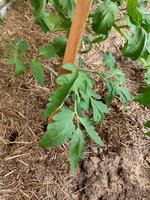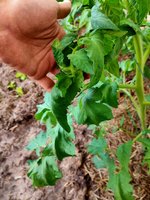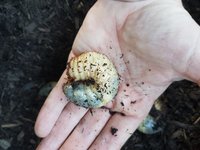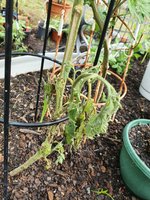You are using an out of date browser. It may not display this or other websites correctly.
You should upgrade or use an alternative browser.
You should upgrade or use an alternative browser.
Problem Tomato wilt
- Thread starter Scott225
- Start date
You say, "during the day"
Do they come good at night, and are they OK in the morning?
If so, it could just be a little bit of heat stress or similar. When do you water them? I suggest to water in the morning, before the heat and try not to get water on the leaves as if it gets hot, the water can burn them.
Do a check with you finger up to your second knuckle into the soil and make sure it is moist but not sodden, if it is only moist for the first inch you may need to give a deeper water.
Do they come good at night, and are they OK in the morning?
If so, it could just be a little bit of heat stress or similar. When do you water them? I suggest to water in the morning, before the heat and try not to get water on the leaves as if it gets hot, the water can burn them.
Do a check with you finger up to your second knuckle into the soil and make sure it is moist but not sodden, if it is only moist for the first inch you may need to give a deeper water.
It's easy to diagnose fusarium wilt by slicing diagonally through the stem.
There will be black dots evident on the cut.
They are actually black lines running right up through the stem and branches.
Usually, it starts in the lowest branch and progresses upwards.
Sometimes there's a bark staining on the actual main stem if the infection is bad.
The stain is due to the number of lines of infection running up the stem.
If it's not fusarium, it could be root nematodes which also cause a form of wilt due to them eating the cells involved in the osmosis of fliud into the roots.
There will be black dots evident on the cut.
They are actually black lines running right up through the stem and branches.
Usually, it starts in the lowest branch and progresses upwards.
Sometimes there's a bark staining on the actual main stem if the infection is bad.
The stain is due to the number of lines of infection running up the stem.
If it's not fusarium, it could be root nematodes which also cause a form of wilt due to them eating the cells involved in the osmosis of fliud into the roots.
Can it still be nematodes with it being a brand new bed?. And can I check for Fusarium by cutting off a lower branch?. Also I forgot to mention before that we have had some sudden very cold nights (no frost) but could that contribute?. Sorry for all the questions.It's easy to diagnose fusarium wilt by slicing diagonally through the stem.
There will be black dots evident on the cut.
They are actually black lines running right up through the stem and branches.
Usually, it starts in the lowest branch and progresses upwards.
Sometimes there's a bark staining on the actual main stem if the infection is bad.
The stain is due to the number of lines of infection running up the stem.
If it's not fusarium, it could be root nematodes which also cause a form of wilt due to them eating the cells involved in the osmosis of fliud into the roots.
Yes to all those.
Ok, well I guess tomorrow I can at least eliminate the Fusarium possibility and chop a branch off. Is it correct that you can not get rid of Fusarium in the soil?. Will report back tomorrow after checking a lower branch. Thank you very much for the help.Yes to all those.
Checked lower branch and no black dots. I read somewhere that too much water and cold can make them do this, I also noticed purple on my plants. Got a soil tester for moisture and it was off the chart wet. Hoping it's just a combination of these two things.
I had fusarium wilt on one plant and the one next to it was fine and after pulling it the good one had stayed healthy.
I have also had a caterpillar inside the stem and as it went through the main stem one branch would die off at a time.
In saying that, in another bed all of the plants were wilting so I pulled the lot and checked the soil and found 11 of these giants.
In Bundaberg we have not only cane beetle but rhino beetles and I find many of those around the garden.
I have also had a caterpillar inside the stem and as it went through the main stem one branch would die off at a time.
In saying that, in another bed all of the plants were wilting so I pulled the lot and checked the soil and found 11 of these giants.
In Bundaberg we have not only cane beetle but rhino beetles and I find many of those around the garden.
Attachments
Hi Cathy,
I had a similar problem with those grubs (curl grubs?). A friend advised to apply molasses diluted in warm water. I think it was about 1 part molasses to ten parts warm water. It seemed to work. Soil structure improved and grubs went elsewhere. The chooks love them too!
I had a similar problem with those grubs (curl grubs?). A friend advised to apply molasses diluted in warm water. I think it was about 1 part molasses to ten parts warm water. It seemed to work. Soil structure improved and grubs went elsewhere. The chooks love them too!
Hi Dan
Curl grubs are the larval stage of a beetle.... so yep a curl grub. The bleeding heart that I am I could not kill these beautiful creatures as they grow into the giant rhino beetle..... however I will give this method a go as so long as they move on I will be happy.
I wonder if I could use that as a preventative during beetle season to stop them from laying eggs in the pots and garden beds?
I lost a HUGE citronella geranium to grubs ...it started wilting and by the time I pulled it out if the pot there was over 20 lawn grubs in the soil eating all the roots and I lost it.
A picture of my most recent tomato plant lost to wilt disease.
Curl grubs are the larval stage of a beetle.... so yep a curl grub. The bleeding heart that I am I could not kill these beautiful creatures as they grow into the giant rhino beetle..... however I will give this method a go as so long as they move on I will be happy.
I wonder if I could use that as a preventative during beetle season to stop them from laying eggs in the pots and garden beds?
I lost a HUGE citronella geranium to grubs ...it started wilting and by the time I pulled it out if the pot there was over 20 lawn grubs in the soil eating all the roots and I lost it.
A picture of my most recent tomato plant lost to wilt disease.
Attachments
Yes, its unfortunate that those hungry beetles grow into those huge beautiful rhino beetles and other similar Christmas beetles etc.
But I find they tend to live harmoniously with my plants.
But then again the plants I have growing in the ground never look that crash hot anyway due to impoverished soil.
I often find them at the bottom of my compost which is fine because that's a place where they are doing good work.
The thing we need to be mindful of re these beetles is that their life cycle extends over several years and do we want to kill off that cycle purely because they are eating some plant roots?
It's like the giant cicada whose life cycle is 17years long. They live in the soil among the roots of their tree, then slowly eat their way up the inside of the native tree trunk and finally emerge through a hole they cut in the fork of a smaller branch.
However, once they get right up there, often the black cockatoos hear them and come in to cut the branch off to get the grub, which is not good for the grub!
But we often see the branch dying on this tree in our gardens and someone will say oh, use insecticide, its a grub. But the poor thing has spent 16 of those 17yrs getting there.
But I find they tend to live harmoniously with my plants.
But then again the plants I have growing in the ground never look that crash hot anyway due to impoverished soil.
I often find them at the bottom of my compost which is fine because that's a place where they are doing good work.
The thing we need to be mindful of re these beetles is that their life cycle extends over several years and do we want to kill off that cycle purely because they are eating some plant roots?
It's like the giant cicada whose life cycle is 17years long. They live in the soil among the roots of their tree, then slowly eat their way up the inside of the native tree trunk and finally emerge through a hole they cut in the fork of a smaller branch.
However, once they get right up there, often the black cockatoos hear them and come in to cut the branch off to get the grub, which is not good for the grub!
But we often see the branch dying on this tree in our gardens and someone will say oh, use insecticide, its a grub. But the poor thing has spent 16 of those 17yrs getting there.
There are at least 4 types of beetles all that produce lava looking like this one.
I have no idea which is edible or maybe all are.
Then there's curl grubs and some even smaller which are in fact dung beetle lava but I wouldn't eat them!
The ones that turn into rhino beetles are HUGE taking up the whole of the palm of your hand and they have the beginnings of the pincers already developing on their heads in that larval stage.
Mostly the ones we see in the garden are Christmas beetle larva. Christmas beetles are the iridescent coloured beetles about 2.5cm long, so much smaller than the grub.
I have no idea which is edible or maybe all are.
Then there's curl grubs and some even smaller which are in fact dung beetle lava but I wouldn't eat them!
The ones that turn into rhino beetles are HUGE taking up the whole of the palm of your hand and they have the beginnings of the pincers already developing on their heads in that larval stage.
Mostly the ones we see in the garden are Christmas beetle larva. Christmas beetles are the iridescent coloured beetles about 2.5cm long, so much smaller than the grub.
Yep, they are certainly beauties, aren't they?
I got a trailer load of soil from a mates place last year and as I was shovelling it out of the trailer I found about a dozen of these grubs. I didn't want them in my raised beds so i decided to take them out the front to give them to the family of magpies that live out the front, but they just turned up their beaks at them. Oh well you can only try.
So we know that these grubs are native Australian fauna. They are the larval stage of the native rhinoceros beetle.
That means that in theory we aren't supposed to kill them!
I know many will laugh at that statement but the technicality is that they are protected.
Just thought I'd throw that into the mix.
I think leaving them in the bottom of the open compost or putting them under a pile of timber or bark or whatever is the best thing.
They might look big, strong and dangerous, but in all honesty, I've never known them to do any more than a small amount of damage to any plant or tree.
That means that in theory we aren't supposed to kill them!
I know many will laugh at that statement but the technicality is that they are protected.
Just thought I'd throw that into the mix.
I think leaving them in the bottom of the open compost or putting them under a pile of timber or bark or whatever is the best thing.
They might look big, strong and dangerous, but in all honesty, I've never known them to do any more than a small amount of damage to any plant or tree.

